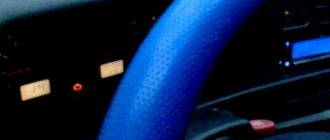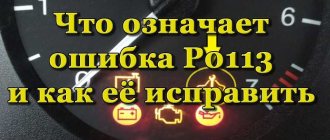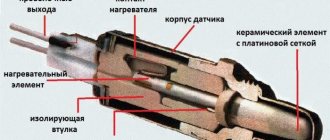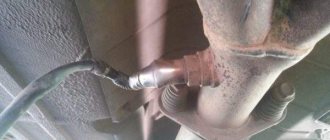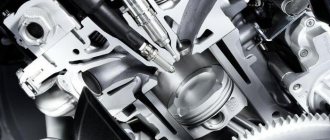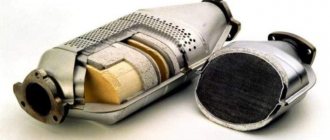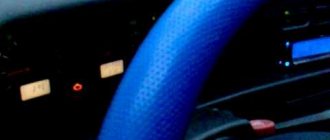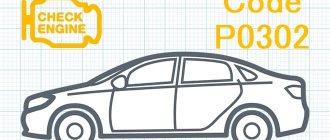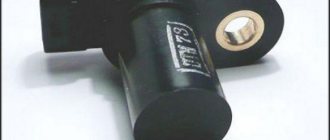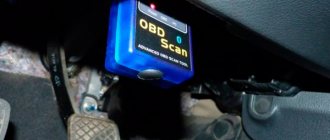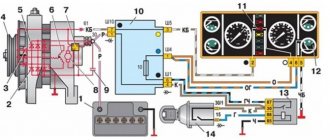Do you experience misfires at idle or under load? Misfire is one of the most common problems when it comes to modern gasoline engines. The spark is critical to the operation of the engine.
There are many reasons that can cause a misfire. They are not easy to eliminate, especially if you don’t know where to look for them.
In this guide, we'll look at the symptoms of misfires, their causes, and how to best troubleshoot them.
What is a misfire?
To know what a skip actually is, we first have to start with the basics of how a car engine works.
Here you can see a good illustration of how the pistons and crankshaft move inside the cylinder when the engine is running. The pistons are pushed down by an explosion inside the cylinder. The piston, moving down, rotates the crankshaft. The operation of an engine can be divided into four stages, which is why this type of engine is called a four-stroke engine.
- The piston moves down, filling the cylinder with the air-fuel mixture from the intake.
- The piston goes up, compressing the air-fuel mixture to high pressure.
- A spark from the spark plug ignites the air-fuel mixture and the explosion pushes the piston down, rotating the crankshaft.
- The piston rises up, squeezing the burnt air-fuel mixture through the outlet.
- Repeat the process from step 1.
This is a description of the operation of a four-stroke engine, which is installed in almost all modern cars. There are some older cars that use a 2-stroke engine, but we won't cover them.
A misfire occurs when one or more of these steps are incorrect or missing.
- The air/fuel mixture is too lean or too rich.
- Bad ignition spark, incorrect ignition timing.
- Low compression, accounting for the air-fuel mixture.
- Incorrect timing of intake or release of the air-fuel mixture.
Now you know the basics of how a cylinder works in a car engine and at what stages misfire can occur. With this knowledge it is much easier to find the reason why misfire occurs.
As you can see, in theory there are not many reasons. But when you start diagnosing your car, you'll realize that it's not always that easy to find the problem. Let's continue to learn how to diagnose and how to fix misfires at home.
How to detect a malfunction yourself
We also recommend reading our expert’s article, in which he talks in detail about what a contactless ignition system is.
Be sure to read our specialist’s article, which tells you how to set the ignition correctly.
In cars with ECU
In cars with an ECU, troubleshooting is a fairly easy task. To do this, you need to connect an autotester and find the error code. If among the error codes there is an indication of a specific cylinder, then you should pay special attention to the condition of the element. Perhaps the problem is hidden in the armor wires or spark plugs that go to this cylinder. The gaskets may also need to be replaced. If a complex error (p0300) is issued, then you should pay special attention to the quality of the fuel and the filter.
Even domestic cars now have electronic units installed. If the car initially has an ECU, but its performance leaves much to be desired, then you can replace the part at a certified service station. The new “brains” must be compatible with the previous model. Thanks to the new electronic control units, you can easily find misfires in the 1st and 4th cylinders of the VAZ-2114 or on any old foreign car, as well as diagnose the operation of the 2nd and 3rd cylinders without unnecessary hassle.
Signs of misfire
There are several different symptoms that you may experience when it comes to engine misfire. Here are some of the most common ones.
Uneven acceleration
When a misfire occurs, you may feel it as a slight or strong jolt coming from the engine. These misfires often occur while the engine is running under load and you are accelerating at high RPMs and high gears. Acceleration problems are a common sign that your engine is misfiring.
Unstable idle
Sometimes there will be passes at idle. The engine sensors receive incorrect readings and the air/fuel mixture becomes incorrect. This can result in a very rough idle. The revolutions can fluctuate up and down until the engine stops.
Vibrations
The car engine is balanced at the factory using various balancers to get as little vibration as possible from it. When one cylinder is not firing properly, the engine becomes unbalanced and this can cause severe vibrations in the cabin during acceleration or idling.
Check Engine light on
Modern cars monitor the status of all engine sensors. If the sensor fails or it senses that something is wrong with the engine, it will send information to the control unit.
When the engine control unit (ECU) receives the data, it will decide whether the problem is serious or not. If the problem occurs repeatedly, the ECU will turn on the Check Engine Light so you can take action.
Slow acceleration
As we said earlier, skipping can cause the oxygen sensors to receive erroneous information and create a mixture that is too rich or too lean.
A mixture that is too lean or too rich can cause sluggish acceleration and even put your car into limp (safety) mode. This will cause the engine to not spin above 3500 rpm and the ECU will turn off the turbo.
Changing the engine sound
If you know a little about cars, you will have noticed that there is a difference in the sound of different engines. V8 engines have a very different tone than a four-cylinder engine.
If your 4 cylinder engine is misfiring in one cylinder, it may sound like a 3 cylinder. If your car sounds unusual, it's most likely misfiring.
Diagnosis and problem solving
Sometimes, when P0301 is detected, no symptoms are observed. The easiest thing to do in this case is just reset the code and see if it comes back.
If the problem manifests itself in the form of uneven idle or engine jerking, check all wiring and connectors leading to the cylinders. Next, it’s worth checking the spark plugs, wires, and coils.
In some cases, the cause is a failed catalytic converter. If you smell a rotten egg smell in your exhaust, the catalytic converter needs to be replaced. Faulty fuel injectors should also not be overlooked.
Random misfires may be due to lean fuel. This may be due to a vacuum leak in the intake manifold or air flowing past the airflow sensor. And also because of the exhaust gas recirculation valve stuck in the open position.
Causes of misfires
Now that you suspect a misfire, where should you start looking for the problem? Here are the most common reasons for absences, ranked from most common to least common.
1. Faulty ignition coil or distributor-breaker (distributor)
If you have an older car, this is the most common reason. Some vehicles have a separate ignition coil for each plug, while others have a single coil with ignition cable for each plug.
Older cars have a breaker and in some cases also an ignition coil. If you have separate coils, then disconnect each one to find out which cylinder is misfiring. Replace the faulty ignition coil.
Faulty spark plugs
The second most common cause of misfires is bad spark plugs. Spark plugs ignite the mixture in the cylinders, and they wear out over time. Spark plugs are inexpensive and easy to replace. If you can't remember the last time you changed your spark plugs, it might be time for it.
Intake manifold leaking
Leaks near cylinder heads are also very common when it comes to spark plugs. This problem was common in older cars without steel intake manifold gaskets.
If you have an old engine, you can check this. If you have a new car, check for other signs of leaks around the intake manifold gasket. Check for damaged vacuum hoses.
Low fuel pressure
May be caused by a faulty fuel pressure regulator, faulty fuel pump, or clogged fuel filter. Low fuel pressure will cause the engine to lean, causing misfire in all cylinders. If you have ignition fault codes on all cylinders, check the fuel pressure.
Injectors
Another problem that used to be common was problems with injectors. A faulty fuel injector can cause a misfire.
This is quite difficult to diagnose without checking the injector operation. Injector problems are not common on new cars, so check for other possible causes first.
Low compression/damage inside the engine
If you've checked everything else, you may have low compression or damage inside the engine. A worn timing belt can also cause low compression - check this first.
Causes of error P0301
- Worn or damaged cylinder 1 spark plug
- Lack of compression in cylinder 1
- Worn or damaged spark plug wires and/or ignition coils
- Damage to the distributor cap (if equipped)
- Worn or damaged ignition distributor runner (if equipped)
- Fuel injector damage
- Clogged pipes or valve of the exhaust gas recirculation system
- Valves burning
- Incorrect ignition timing setting
- Vacuum leak
- Low level or low fuel pressure
- Damage to the cylinder head gasket
- Distributor cap wear
- Camshaft position sensor malfunction
- Malfunction of the crankshaft position sensor
- Air flow sensor malfunction
- Oxygen sensor malfunction
- Throttle Position Sensor Malfunction
- Malfunction of the catalytic converter
- PCM malfunction
Is it safe to drive with a misfire?
If a leak occurs, the air-fuel mixture entering the engine will come out unburnt. Modern cars have a catalytic converter that reduces emissions from the car. The catalyst can heat up to 600 degrees during operation.
And what happens when the unburnt air-fuel mixture gets into it? That's right, it will explode inside the catalyst. Explosions inside the catalytic converter can damage it. And a new catalyst is not a cheap pleasure.
In addition, misfires can also damage other sensors in the engine, such as oxygen sensors. We would never recommend driving a vehicle with a misfire, especially over long distances. Short distances to a service station without stress on the engine are normal, but don't ignore gaps and continue driving.
On which cars is this problem most common?
The problem with code P0301 can occur on different machines, but there are always statistics on which brands this error occurs more often. Here is a list of some of them:
- Audi (Audi a3, Audi a4, Audi A5, Audi a6, Audi TT)
- BMW (BMW X3, BMW X5, E60)
- Chery
- Chevrolet (Chevrolet Aveo, Impala, Captiva, Cruz, Lacetti, Orlando, Spark)
- Chrysler (Chrysler Town Country, 300c)
- Citroen
- Daewoo (Daewoo Nexia)
- Dodge (Dodge Caravan, Stratus)
- Fiat
- Ford (Ford Mondeo, Ranger, Taurus, Focus, Escort)
- Geely (Gili Emgrand)
- Honda (Honda Accord, Pilot, SRV, Civic, Element)
- Hummer H3
- Hyundai (Hyundai Accent, Getz, Santa Fe, Solaris, Tucson, Elantra)
- Infiniti
- Jeep (Jeep Grand Cherokee)
- Kia (Kia Rio, Sid, Sportage)
- Lexus (Lexus rx300, rx350)
- Mazda (Mazda 3, Mazda 6, Mazda cx7, Mazda cx9)
- Mercedes (Mercedes w203)
- Mitsubishi (Mitsubishi Outlander, Galant, Lancer, Pajero, L200)
- Nissan (Nissan Almera, Qashqai, Murano, Tiida, X-Trail)
- Opel (Opel Antara, Astra, Vectra, Zafira, Insignia, Corsa, Meriva)
- Peugeot (Peugeot Boxer)
- Renault (Renault Duster, Logan, Sandero)
- Saturn (Saturn SC)
- Skoda (Skoda Yeti, Octavia, Fabia)
- Ssangyong (Sangyong Kyron)
- Subaru (Subaru Forester)
- Suzuki (Suzuki Grand Vitara, sx4)
- Toyota (Toyota Avensis, Camry, Corolla, Prius, Rav4, Highlander)
- Volkswagen (Volkswagen Golf, Passat, Polo Sedan, Touareg, Tiguan)
- Volvo
- VAZ 2107, 2110, 2112, 2114, 2115
- Volga Cyber
- Gazelle Business, umz 4216
- Lada Vesta, Granta, Kalina, Largus, Niva, Priora
- UAZ Patriot
With fault code P0301, you can sometimes encounter other errors. The most common ones are: P0118, P0134, P0175, P0300, P0302, P0303, P0304, P0305, P0306, P0202, P0507.
How does the ECU know when misfires occur?
The ECM may detect misfires differently depending on the vehicle model and engine. The ECU uses many sensors to know when to fire the spark plug, when to inject fuel into the cylinder, and how to change the air-fuel mixture. To detect misfires, the control unit often uses a crankshaft sensor.
Engine ECU
The crankshaft sensor measures the position of the crankshaft and calculates its revolutions per minute. The crankshaft sensor uses the camshaft sensor to determine which cylinder is at top dead center and ready to ignite.
Pushing the pistons down causes a slight increase in crankshaft speed. If the crankshaft sensor does not recognize this increase in speed, the engine control unit will store a fault code on the cylinder on which the misfire occurred.
Sometimes the control unit cannot determine which cylinder is misfiring and it stores the error code P0300 (random misfire).
Some ECUs use ignition coil resistance. When ignition does not occur, the control unit understands this through the electrical wiring, which leads to an error. This method is not as common as detection using the crankshaft sensor.
What does P0301 mean?
In most cars the engine has 4-6 cylinders. A spark plug fires sequentially in each cylinder, igniting the fuel mixture. Energy is then released from the fuel to drive the crankshaft, which must rotate smoothly as the vehicle moves.
All cylinders work together to ensure continuous rotation of the crankshaft. If a cylinder misfires, it will cause the crankshaft speed (RPM) to increase or decrease.
If the crankshaft speed increases or decreases by 2 percent or more, P0301 will remain in the PCM (automatic transmission control module) memory.
If the RPM increases or decreases by 2 to 10 percent, the Check Engine Light will illuminate on your vehicle's dashboard. If the deviation percentage exceeds 10 percent, the Check Engine light will flash, indicating a more serious problem is present.
Trouble code P0301 indicates that cylinder 1 is misfiring.
How to diagnose and fix omissions
If you read the article from the beginning, you now know what can cause gaps. If you came straight to this point, then we will briefly write down the possible reasons for you. Omissions occur when one of the following is missing or occurs at the wrong time:
- Ignition.
- Fuel-air mixture.
- Compression.
To diagnose omissions, we must check everything. But some mistakes are more common than others. Starting in the right direction can save you a lot of time. Let's write a short guide on what to do when trying to find the cause of a misfire.
Reading errors
The first thing to do is read the errors from the ECU. You can do this yourself using a diagnostic scanner or an ELM327 adapter with Torque or ScanMaster software.
If you find errors in the controller code memory, write them down and erase them. We will need them in the next step.
2. Use the information you receive
Now that you know the error code, you need to understand what it says. Further diagnosis depends on this.
Case 1: You have counted many misfire error codes on different cylinders. Additionally, there are errors related to the air-fuel mixture.
For example. If you have two or more of these trouble codes:
- P0171 - lean mixture;
- P0300 - random misfires;
- P0301, P0302, P0303, P0304 - misfires in cylinders 1-4.
In this case, if the engine is running rough or unstable, you should start repairs with the air-fuel mixture. Most likely problems with it are caused by omissions. If you have looked for a code related to the air/fuel mixture along with a skip code, always start your search with the mixture. There are times when mixture errors occur due to omissions, but this happens rarely.
Common causes should be checked. Start with air leaks around the intake manifold and check the hoses for cracks. You can use brake cleaner or "quick start" spray to gently spray around the intake while the engine is idling. If the rpm goes up, there is an air leak. Remember that these sprays burn very easily, so have a fire extinguisher ready just in case.
If there are no intake leaks, the next step is to look into the trouble code related to the air-fuel mixture. You can use Google to find the possible causes of this fault code and how to resolve it.
Case 2: You read a fault code on a specific cylinder again and again despite erasing it
If you're getting an error on a specific cylinder all the time, or just misfire errors with no other associated trouble code, just read on. This problem is much easier to solve. We'll cover this in the next step.
Check ignition
It's time to check the ignition. Because in most cases the problem is caused by a faulty ignition. Here's where we'll start. If you have an older car with an ignition distributor, always start by checking the inside of the distributor. It is often worn out.
If the engine idles rough and if you have an engine with separate ignition coils. You need to start it, let it run at XX, and then disconnect one coil in series. Remember that ignition coils have very high voltage and you must be very careful.
If you disconnect the ignition coil and do not feel any difference in engine performance, you have found a cylinder that is misfiring.
You can use this same procedure with older vehicles that use multipoint ignition. Disconnect the spark plug wires until you know which cylinder is not firing.
During work, you must use insulated tools or protective equipment. If you disconnect wires with your hands without any insulation, you may become exposed to voltage. Always use the correct tools or disconnect wires with the engine off.
Video on how to check the spark:
Now that you know exactly which cylinder is not working, you can change the ignition coil (wires) with the working cylinder. If the problem moves to another cylinder, replace the ignition coil (cable).
If the problem remains on the same cylinder, you can do the same with the spark plugs. Change the spark plugs between the two cylinders. If the problem moves, replace the spark plugs.
How does a mechanic diagnose a P0301 code?
When diagnosing this error code, a mechanic will do the following:
- Reads all data and error codes stored in the PCM memory using an OBD-II scanner
- Clear error codes from the PCM memory and test drive the vehicle to see if P0301 appears again
- Check the cylinder 1 spark plug wire for wear and damage.
- Check the cylinder 1 spark plug for wear and damage.
- Check the ignition coil for wear and damage
- Check the ignition coil wire for wear and damage.
- If necessary, replace spark plugs, ignition coils, and related wires
- If P0301 appears again after replacing the above components, check the fuel injector and related wires for damage.
- Check the ignition distributor cap and slider (if equipped) for corrosion and damage
- If there are other error codes stored in PCM memory along with P0301, it will clear all present errors.
- Test drive the vehicle to see if P0301 appears again
- If P0301 appears again, check compression in cylinder 1
- If P0301 persists, the problem may be a faulty PCM. In this case, the module may need to be replaced or reprogrammed.
Common errors when diagnosing code P0301
The most common mistake when diagnosing a P0301 code is to replace the spark plugs, ignition coils, and related wires when the problem is damaged fuel injector wires.
Another mistake is to rule out the possibility of failure of the fuel injector itself, the cylinder or the PCM.
Also, mechanics often don't look at other error codes that appear along with the P0301 code. If you do not resolve all present errors, this may cause the P0301 code to appear again.
Conclusion
- Ignition coils and bad spark plugs are the most common problem if you have a misfire.
- Intake leaks are a common problem if you have a trouble code related to the air-fuel mixture.
- If you have an air mixture fault code, always start checking there.
I hope you learned something and solved your misfire problems.
Previous post Idle air control (IAC) - how it works, malfunctions, symptoms, testing
Next entry Error P0339 - what it means, symptoms, causes, diagnosis, solution
Symptoms of malfunction
The main driver symptom of P0301 is the MIL (Malfunction Indicator Light) illumination. It is also called Check engine or simply “check light”.
They can also appear as:
- The “Check engine” warning light on the control panel will light up (the code will be stored in the ECM memory as a malfunction).
- The engine stalls or has trouble starting.
- Floating speed, as well as attempts to stall at idle.
- Jerking/misfire at idle or under load.
- Poor speed gain.
- Increased fuel consumption.
- Reduced engine power.
- Smell of fuel from the exhaust.
This malfunction is considered serious and must be corrected as soon as possible. Because prolonged driving with a misfire can cause costly damage to the engine and catalytic converters.
Related DTC Discussions
- 99 Honda Odyssey P0304, P0305, P1399
Hello. I have a 1999 Honda Odyssey that developed a problem overnight. When I started the car to check (my wife's car, so she reported the problem), I immediately noticed that it was very missing. The motor has about 130k and it had a new set of Denso forks about 10k ago and it has run great its whole life... - 2005 F-150 5.4L Cold/Open Circuit Misfire P0304, P0308, P0300
Every time I start my truck it misfires P0304, and/or P0308, and/or P0300 (less frequently). Once it warms up, it clears up. But it still feels like I'm lacking in strength. Replaced spark plugs, injectors, COPS, fuel filter. Find vacuum leaks (spray carburetor cleaner, even birth control device... - 2006 FORD F150 code P0302, P0304
Hi, Replaced spark plugs, coils, reversed coils and injectors are still misfiring on cylinders #2 and #4. Help is needed. BAST…. - 2003 Honda Civic EX P0300, P0302, P0301, P0303, P0304
Any help would be greatly appreciated! ———————————————- Year: 2003 Make: Honda Model: Civic Engine: 1.7L SOHC 4 cylinder (D17A6) Mileage: 43,000 In storage: P0301 Cylinder 1 misfire detected P0302 Cylinder 2 misfire detected P0303 Cylinder 3 misfire detected P0304 Cylinder 4… - obd2 codes p0304, p0305, p0306 and p0402 on a 2001 v6 mustang
I am getting these codes and I was wondering if anyone could tell me why I am getting these codes!! any help would be greatly appreciated! I know what the codes mean, but I have no idea what the reasons are or what steps to take to possibly find out why I'm getting these codes!!! pl... - '01 Durango 4.7L - P0304 Cylinder Misfire
This is my first time asking for help on any forum; but as I've read, they seem very useful. I have a 2001 Durango 4.7L with code P0304. I know it's a misfire on cylinder #4; It runs rough no matter what I do, day/night, hot/cold, low or high rpm. Replaced the spark plugs with ne... - 2006 dodge ram hemi v8 codes p0202, p0204, p0304
My 2006 dodge ram hemi v8 started misfiring out of nowhere, it says injector 4 and cylinder 4, so I switched #4 to #2 and didn't solve the problem, now the code injector #2 turns on so I have two p0202′ p0204, I don't know what it could be, please help…. - 1997 Chevy Silverado 5.7 2WD P0304
Codes indicate misfire on cylinder #4. I replaced the spark plug, changed the plug wires, replaced the distributor cap and had the fuel intake system cleaned at Firestone. I'm still getting the same code and I'm losing about 80-90 miles on a full tank. I also still have vibration. The remaining traffic jams may be two months old... - 1999 Pontiac Bonneville error code P0304.
Hey guys, I'm new to the forums but have seen some really great information being shared and thought you could help me too! I have a 1999 Pontiac Bonneville with the 3.8L V-6 engine with 121,100 miles on it. Overall the car drives great, but sometimes when driving on the freeway, when... - P0304 on a 2002 Chevy S-10
Okay, (today is Saturday 5/5/2012 at about 5:00) So I have a 2002 Chevy S-10 with 47,000 miles, it's an automatic 4x4 with 4.3- liter engine (whatever the standard Chevy V6 is, ... its 350, which is missing 2 cylinders)…. so I'm only getting this misfire on cylinder #4. I recently did some work with Tru...
avtoexperts.ru
One fine day, when I drove the car, I noticed that when I changed gears, I felt twitching, and then the Check Engine came on. After diagnostics, it turned out that one of the cylinders had misfired. The damage was eliminated by replacing the armored wires. At the same time, I decided to study the whole topic more deeply by interviewing familiar masters and chatting on forums. In this article you will learn what misfires are, what other reasons there are and what to do about it. So, let's begin.
In the photo: ignition of fuel in the cylinder
Misfire is a malfunction of the internal combustion engine when the fuel in the cylinder does not ignite. As a result, the engine begins to “sneeze”, trip, twitch, and moreover, power is lost, since one of the cylinders stops working or works intermittently. In addition, such a malfunction is often accompanied by pops and shots from the exhaust pipe. This happens because the unburned mixture enters the exhaust manifold.
What are the signs?
Depending on the type of internal combustion engine, say an injection or carburetor engine, the symptoms accompanying such a problem may differ. So:
1. When working on a carburetor, the engine begins to “trouble”, “shots” from the exhaust occur, power is lost, and a burning smell is felt. In addition, the engine starts poorly, the engine often stalls, even under light load, and fuel consumption increases.
2. In addition to similar symptoms as carburetor injectors, other signs may appear on injectors. For example, the “check” lights up, the car’s ECU records gaps in memory.
By the way, this feature on injection engines, the ECU, after recording the error and entering it into memory, can simply turn off the supply of fuel to the problem cylinder. This happens according to the following scheme: the “brains” analyze the data from the crankshaft position sensor, its speed, the number of cylinders involved, and then it switches off if a certain number of misfires have been recorded.
Also, signs of misfire include severe shaking of the car both “cold” and “hot”.
What reasons?
There are a huge number of reasons, here are some of the most common examples:
1. The ignition system is at fault, that is, problems with armored wires (you can often hear on forums that leaks occur due to a broken high-voltage wire), coil, distributor (carburetor internal combustion engines), spark plugs. It is not uncommon, especially in winter, for condensation to form in the spark plug wells, which is why the coil begins to “punch” into the block.
Blue armored wires
Also, one should not forget about problems in electronics, namely with “brains” that incorrectly “interpret” information from sensors and accordingly send incorrect data to the injectors.
In addition, from the same forums we learned real-life cases when for a long time they could not understand why the diagnostics showed misfires in four cylinders at once, and after resetting the errors, everything disappeared and operation returned to normal. It turned out that the problem was poor contact of the “ground” coming off the coil.
And of course, don’t forget to check the spark plugs and coils.
Old and new spark plugs
2. Fuel and air system. Clogged air and fuel filters, dirty injectors, interruptions in the power supply to the injector (open circuit of a specific injector).
By the way, the most likely way to indicate a problem with the power supply to the injectors is that when the engine is “cold,” it starts to “sputter,” and as soon as it warms up, the problem goes away. But, if gaps are already “hot”, then you should look for the reason in something else.
In the photo: faulty Volkswagen Scirocco injectors
Causes may also include air or fuel leakage or improper operation of the fuel pump. For example, fuel is supplied at too low a pressure. It would be a good idea to check the pressure regulator in the fuel rail. Sometimes, due to water getting into the tank or poor fuel quality, there are gaps.
3. Reduced compression in all cylinders or its uneven distribution. Do not forget that low compression, in turn, indicates problems of such a nature as: wear of the piston group, malfunction of the timing belt.
In the photo: compression measurement
On the forums you can often hear that the reason for the omissions on the domestic Lada Priora, Granta, Kalina, the “Ten” family, and the Classic may be a broken key or a timing chain sprocket mounting bolt. As a result, the pulley turns and the ignition is shifted. Incorrect timing adjustment is also the cause of misfires.
In addition, incorrectly adjusted valve clearance also causes misfires. For example, insufficient contact between the valve “plate” and the “seat”, as a result, the tightness of the combustion chamber is broken. Or the valves burn out completely, and the seal of the chamber is similarly compromised.
How to diagnose?
Depending on which engine, for example, computer diagnostics will not be suitable for carburetor internal combustion engines, they must be dealt with using the method of elimination. That is, check one by one - armored wires, spark plugs, coil, distributor-switch (distributor), fuel pump, wiring, fuel quality.
With injection systems, things are much simpler; you just need to undergo computer diagnostics. But, it’s worth downloading, which is not always the case, and it will show the malfunction and the reason. But first, of course, it’s worth trying to diagnose the malfunction yourself, maybe the injectors or spark plugs are clogged, or there are problems with the armored wire.
If you were unable to find out the reason yourself, you can go to the service. There, with the help of special testers and scanners, they will read the errors stored by the ECU. When it comes to misfires, the system records error codes depending on which cylinder misfired. So, the codes:
• P0301 - problems with the first cylinder.
• PO302 - malfunction in the second cylinder.
• PO303 - misfires in the third cylinder.
• PO304 - problems with the fourth cylinder.
Diagnosis of misfires
That is, it is clear that the fifth digit in the code indicates the cylinder number. Depending on the modification of the internal combustion engine, there may be 12, 8, 6, 4. Accordingly, code PO3012 indicates a problem with the 12th cylinder.
Type codes - PO20X, indicate problems with the injectors. X indicates the number of the cylinder in which the injector is located.
Errors with code PO40 indicate a problem with the exhaust manifold.
Please note that if the scanner cannot accurately determine the cause, then the error is stored under the number PO300, then you have to diagnose everything manually.
Conclusion
As you can see, there are plenty of reasons why misfires can occur; they are varied and can indicate problems with a particular component of the machine, low-quality fuel, and the like. Therefore, if you begin to notice at least one of the signs we listed above, try to go to a service station as soon as possible and get diagnosed. Or, as a last resort, try to figure out the problem yourself, based on the most common reasons we have given. Because ignoring misfires can lead to other problems with the internal combustion engine in the future.
Technical description and interpretation of error P0304
The OBD-II error code P0304 is a generic one that reads “Cylinder #4 misfire detected.” Set when the PCM (powertrain control module) detects a misfire in the fourth cylinder.
The misfire detection system uses input data that is sent to the PCM through dedicated feedback circuits. If the PCM does not receive feedback, it interprets this as a misfire.
Trouble code P0304 indicates that the fourth cylinder is misfiring. They occur when insufficient fuel is burned in the cylinder. Efficient combustion of fuel is important. Because fuel combustion is the source of energy for engine operation.
Misfires can be caused by many reasons. Due to a faulty ignition system, fuel system or internal engine failure. Often the fault occurs due to worn spark plugs, spark plug wires or a faulty coil.
Common errors when diagnosing code P0304
The most common mistake when diagnosing a P0304 is failure to follow the diagnostic protocol. It is also a mistake to replace spark plugs, ignition coils, and related wires when the problem is an intake air leak or a malfunction of the fuel injection system. Before replacing any components, you must perform a thorough diagnosis and consider all possible causes of the error.
ECU codes on the car
The control unit reacts to errors in different ways. To do this, it uses many sensors that help determine the timing of spark plug ignition, fuel injection, and mixture changes. Misfires are detected by the crankshaft sensor. The movement of the pistons causes an increase in speed, which is recorded by the sensor. If the speed increase is not detected, the ECU stores a cylinder fault code. When it is impossible to determine the location of the breakdown, error P0300 appears.
Reading errors on the ECU
To do this, use an OBD2 scanner, ScanMaster or Torque program. The budget reader is Scan Tool Pro Black Edition. He tests not only the engine, but also other systems of the car. The scanner is compatible with most vehicles manufactured after 1993.
The device is easy to use and has an expanded range of functions. Detected codes must be written down on paper. The scanner memory is then cleared.
Troubleshooting
If several codes are detected, perform the following actions:
- Check for errors related to the quality of gasoline or gas entering the cylinders. Sometimes they appear due to misfires.
- Check for air leaks near the intake manifold. Inspect flexible tubes for cracks and breakdowns. Spray “Quick Start” spray near the manifold when the engine is running cold. An increase in speed indicates a leak. The aerosol is highly flammable, so keep a fire extinguisher handy.
